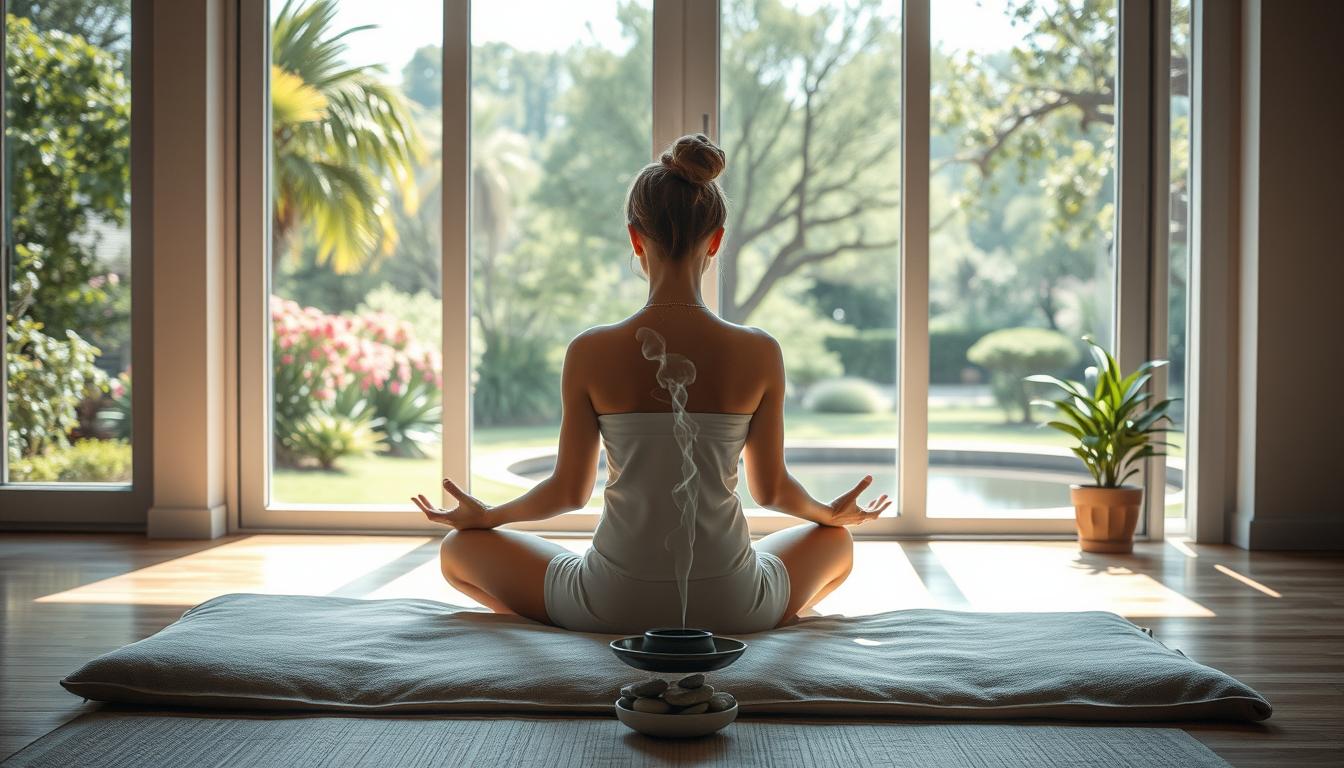I’ve always been fascinated by how something as simple as sitting quietly for a few minutes can have profound effects on our wellbeing – that’s the magic of meditation. In our fast-paced world, where stress seems unavoidable, I’ve discovered that tension relief meditation offers a practical escape.
Through my own journey with meditation, I’ve experienced firsthand how it can transform stress responses and create a sense of calm. This article will walk you through various techniques specifically designed for tension relief, exploring the health benefits along the way.
Key Takeaways
- Discover simple meditation techniques for quick relaxation
- Learn how to reduce stress effectively using meditation
- Understand the connection between meditation and overall wellbeing
- Explore practical tips for incorporating meditation into daily life
- Find out how meditation can improve mental clarity and focus
Understanding Tension Relief Meditation
Meditation for tension relief is an easily accessible practice that can make a significant difference in our daily lives. As we explore this practice, we will understand what it entails and how it differs from other forms of meditation.
What is Tension Relief Meditation?
Tension relief meditation is a subset of meditation practices that are specifically designed to release physical, mental, and emotional stress from our body and mind. It is centered around making us more aware of our bodily sensations, encouraging conscious breathing, and focusing gently on areas where we hold tension.
How it differs from other meditation practices
Unlike some meditation practices that are geared mainly toward spiritual growth, tension relief meditation practice is focused on helping us manage and reduce stress in our everyday lives. Some key aspects that make it unique include:
- Its accessibility – you don’t need to dedicate hours or master complex techniques to experience its benefits.
- It works with our natural physiology, activating the parasympathetic nervous system to counteract stress.
- It often produces immediate physical sensations of relaxation, making it more rewarding and easier to practice, especially for beginners.
- It gives you something specific to focus on, like your breathing or body sensations, instead of trying to empty your mind.
As we can see, tension relief meditation is a practical and accessible form of meditation that is geared toward reducing stress and promoting relaxation in our daily lives.
The Science Behind Meditation and Stress Reduction
The science behind meditation reveals its powerful effects on stress reduction. When we meditate, our body and mind relax, stimulating the parasympathetic nervous system. This causes a decrease in the release of stress hormones like cortisol and epinephrine.
How Meditation Affects the Nervous System
Meditation flips the switch from the “fight or flight” mode, triggered by stress, to the “rest and digest” mode. This shift allows our bodies to repair and recover. Research shows that regular meditation practice can lead to lasting changes in how our bodies respond to stress triggers.
Physiological Changes During Meditation
During meditation, several physiological changes occur: breathing slows, blood pressure decreases, heart rate drops, and brain waves shift to patterns associated with relaxation and focus. A 2018 study found that medical students who meditated for just 10 days experienced a 12% decrease in stress. Regular practice can lower blood pressure, reduce strain on the heart, and decrease other cardiovascular risk factors, ultimately improving overall health.
- Meditation creates measurable changes in our bodies and brains, affecting stress levels and overall well-being.
- By reducing stress, meditation can help lower blood pressure and heart rate, contributing to better cardiovascular health.
- Studies have shown that regular meditation can lead to significant reductions in stress, improving overall health.
The Powerful Benefits of Meditation for Tension Relief
The benefits of meditation for tension relief are multifaceted and well-documented. Research has shown that regular meditation practice can lead to significant improvements in both physical and mental well-being.
Immediate Benefits for Stress Reduction
One of the most remarkable aspects of tension relief meditation is how quickly you can feel its effects – sometimes within just a single session. I’ve experienced a noticeable drop in muscle tension, especially in my shoulders and jaw, slower breathing, and a sense of calmness that replaces racing thoughts.
Long-term Health Improvements
Beyond the immediate benefits, regular meditation practice creates impressive long-term health improvements. Studies have linked consistent meditation to reduced anxiety and depression symptoms, improved sleep quality, better pain management, and even enhanced immune function. Meditation can also help with specific health conditions such as irritable bowel syndrome (IBS), post-traumatic stress disorder (PTSD), and fibromyalgia.
The cognitive benefits of meditation shouldn’t be overlooked either. Regular practitioners often report better focus, improved memory, and greater emotional resilience when facing life’s challenges. By incorporating meditation into your daily routine, you can develop a fundamentally different relationship with stress and achieve sustainable energy rather than burnout.
Mindful Breathing Technique for Quick Tension Release
In my experience, the most straightforward and effective method for immediate tension relief is the mindful breathing technique. This practice is based on focusing your attention on your breath, which can help calm your mind and reduce stress.
Step-by-Step Breathing Practice
To start this meditation practice, sit or stand in a calm, quiet place with your eyes closed or gazing downward. Set a time limit, especially if you’re just starting out – it can be five or 10 minutes. Make sure you are stable and in a position you can comfortably stay in throughout the practice. Focus on your breathing by observing your torso expanding and contracting, or feel the sensation of breath inside your nostrils. As you focus on your breath, you can also notice thoughts, emotions, and sensations as they arise.
As explained in details in a study published by Mayo Clinic, meditation can have a positive impact on our well-being.

How to Incorporate into Daily Routine
To incorporate this practice into your daily routine, try attaching it to existing habits like taking a few minutes of mindful breathing before checking email or while waiting for coffee to brew. Even just 2-3 minutes of focused breathing can shift your nervous system from stress mode to calm mode. As you get more comfortable with the practice, you can extend the time or practice it more frequently, making it a part of your daily routine and enhancing your overall well-being by reducing tension in your body.
Body Scan Meditation for Physical Tension Relief
I’ve found that body scan meditation is particularly effective in managing my physical tension, especially after long, stressful days. This practice involves systematically bringing attention to different parts of your body, from your toes to the top of your head, noticing sensations without trying to change them.
Performing a Body Scan
To start, I lie down or sit comfortably, close my eyes, and take a few deep breaths to settle in. I then direct my attention to my feet and slowly work my way upward, bringing a curious, non-judgmental awareness to each body part. When I discover areas of tension, I imagine my breath flowing into that area, softening and creating space around the discomfort.
Benefits for Chronic Tension and Pain
Research on mindfulness meditation shows it’s particularly effective for chronic pain conditions, not by eliminating pain entirely, but by changing our relationship to the sensations and reducing suffering. A major review of 38 studies found that mindfulness meditation could reduce pain, improve quality of life, and decrease symptoms of depression. By incorporating this practice into my routine, I’ve experienced significant relief from physical tension.
Loving-Kindness Meditation for Emotional Tension
During times of emotional turmoil, I turn to loving-kindness meditation to help calm my mind and thoughts, and bring more compassion into my life. This type of meditation, also known as Metta meditation, begins with developing kind thoughts and feelings toward yourself.
Practice Instructions
To practice loving-kindness meditation, start by silently repeating phrases of goodwill, such as “May I be happy, may I be healthy, may I be safe, may I live with ease.” Begin with yourself, then gradually extend to others – from loved ones to neutral people, and finally to those you may struggle with.
How it Reduces Emotional Stress
Research has shown that this form of meditation increases compassion toward self and others, creating a buffer against emotional stress. As we cultivate kindness and forgiveness, we may find that we are more resilient to emotional tension, and that it may help us respond rather than react to challenging situations.
Guided Visualization for Deep Relaxation
Guided visualization is a powerful tool for achieving deep relaxation. This technique engages your imagination to create a mental vacation, transporting you to a peaceful, safe place where tension naturally melts away.
Step-by-Step Visualization Process
To start, get comfortable, close your eyes, and take several deep breaths. Then, begin to construct a detailed mental image of a relaxing environment – it could be a quiet beach at sunset, a forest, a mountain vista, or a cozy room. The key is to engage all your senses: imagine the sounds, smells, physical sensations, and even tastes that might be present.
For example, if you’re visualizing a beach, you might imagine the sound of gentle waves, the smell of salty air, the feeling of warm sand beneath you, and the taste of salt on your lips.
Best Scenarios for Tension Relief
Guided visualization is particularly effective for specific types of tension. You can use a “light” visualization to imagine healing light flowing through tense areas for physical discomfort, or a “safe place” visualization for anxiety. Research supports the effectiveness of this technique: one study found people who practiced guided meditation experienced improved attention and reduced mind-wandering.
Over time, regular practice creates a mental shortcut to relaxation, allowing you to access your “peaceful place” quickly in stressful situations. As you adapt this technique to your specific tension patterns, you’ll find it becomes a valuable tool for releasing work stress, healing physical pain, or finding emotional peace.
5-Minute Meditation Techniques for Busy People
For those who believe they are too busy to meditate, there are simple, quick practices that can bring significant benefits. Even dedicating a short period each day to meditation can be beneficial.
Some quick meditation practices include the “3-3-3 method”—3 minutes of focused breathing, noticing 3 physical sensations in your body, and identifying 3 sounds in your environment. Another effective technique is the “STOP” method: Stop what you’re doing, Take a breath, Observe how you’re feeling, and Proceed with awareness.
Maximizing Benefits in Minimal Time
Research supports the idea that even short periods of meditation can be beneficial. A study found that meditating for just 13 minutes daily enhanced attention and memory after 8 weeks. For maximum convenience, use transition moments in your day for these quick practices.
Some other quick practices can be done while waiting for coffee to brew or before a meeting starts. The key is to be fully engaged during these short sessions. For instance, 5 minutes of completely focused practice is far more beneficial than 20 minutes of distracted meditation.
| Meditation Technique | Time | Benefits |
|---|---|---|
| 3-3-3 method | 3 minutes | Reduce stress, increase focus |
| STOP method | 2-3 minutes | Improve awareness, reduce tension |
| Focused breathing | 5 minutes | Enhance relaxation, improve mental clarity |
Creating a Sustainable Meditation Practice for Ongoing Tension Relief
Making meditation a regular part of your routine can have a significant impact on your stress levels. To achieve this, it’s essential to set up a meditation routine that fits into your daily life.
Setting up a Meditation Routine
When starting a meditation practice, consider your daily schedule and find a consistent time to meditate. For instance, you can try meditating right after brushing your teeth or before your morning coffee, as this can help you establish a consistent habit. As noted by research, “people who meditate regularly experience cumulative benefits.”
Overcoming Common Obstacles
Some common obstacles to maintaining a meditation practice include finding quiet time and dealing with a wandering mind. To overcome these challenges, you can try unconventional approaches like meditation during your commute or use guided meditations to provide structure.
As you continue with your meditation practice, you’ll find that it becomes an integral part of your daily routine.

Conclusion: Embracing Meditation as Your Tension Relief Tool
After delving into the various forms of meditation for tension relief, we can conclude that incorporating these practices can lead to significant improvements in our overall well-being.
The different meditation techniques explored offer various pathways to achieve a calmer mind and more relaxed body.
Research has consistently shown the benefits of meditation for reducing anxiety, improving sleep, enhancing focus, and supporting overall health.
Some key findings include:
- the flexibility of meditation practices that can fit into any lifestyle,
- the fact that meditation addresses tension at its source,
- a study found people who practiced regular meditation reported lower stress levels,
- even small daily investments in meditation may help create meaningful changes in how we experience tension.
As you consider incorporating meditation into your daily routine, remember that it is a skill that develops over time.
I encourage you to approach it with curiosity, exploring different mindfulness meditation approaches to find what works best for you.
FAQ
What is the ideal time to meditate for tension relief?
I find that meditating at the same time every day, like first thing in the morning or right before bed, helps create a consistent routine and can be really helpful for managing tension.
Can meditation help reduce anxiety and depression?
Yes, meditation has been shown to help reduce symptoms of anxiety and depression by promoting relaxation and reducing stress – it’s like giving your mind a break from the constant stream of thoughts.
How does meditation affect blood pressure?
Research has found that regular meditation practice can help lower blood pressure by reducing stress and promoting relaxation, which can have a positive impact on overall heart health.
Can I meditate if I’m experiencing chronic pain?
Absolutely – meditation can be a powerful tool for managing chronic pain by helping you focus on the present moment and reduce tension in the body.
How long does it take to experience the health benefits of meditation?
Some people report feeling more relaxed and centered after just a few minutes of meditation, while others may take a few weeks of regular practice to notice significant changes – it’s all about being patient and consistent.
Can meditation help improve my sleep?
Yes, practicing meditation before bed can help calm the mind and body, making it easier to fall asleep and stay asleep – I’ve found it really helpful for getting a good night’s rest.
What are some simple ways to incorporate meditation into my daily routine?
You can start by setting aside just a few minutes each day to meditate, using a guided meditation app, or practicing mindfulness while doing everyday activities like eating or walking – it’s all about finding what works for you.
Can meditation help improve my memory and clarity?
Research has shown that regular meditation practice can help improve memory and clarity by reducing stress and promoting a sense of calm and focus – it’s like giving your mind a clear direction.
